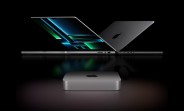We’re past being surprised by the Galaxy S23 series dominating our news section to which week 3 made no exception.
Samsung announced the 200MP ISOCELL HP2 sensor that will be the headline feature of the Galaxy S23 Ultra. The imager is 1/1.3” in size with 0.6μm pixels and can pixel-bin (Tetra2pixel, per Samsung’s lingo) 4-to-1 for 1.2μm pixels and 50MP resolution or 16-to-1 for 2.4μm pixels and 12.5MP resolution. The sensor comes with Dual Vertical Transfer Gate (D-VTG) to avoid blown highlights. It claims to increase the full well capacity by more than 33%, meaning that an individual pixel can gather a third more light before it clips. Super QPD technology recognizes both horizontal and vertical patterns so it can deliver fast and accurate AF even in low-light conditions.
The ISOCELL HP2 is the first sensor that employs Samsung’s DSG (Dual Slope Gain) feature in 50MP mode. It applies two separate conversion values to the analog signal received at the pixel level, bringing a “super HDR performance”. This means that it can capture the two exposures simultaneously avoiding the risk of detail loss in the conventional HDR mode. Also, this enables it to take 4K HDR videos at 60fps.
The Galaxy S23 series will use a custom Snapdragon 8 Gen 2 chipset with a higher clock speed, called “Qualcomm Snapdragon 8 Gen 2 Mobile Platform for Galaxy”.
We also got detailed tables that reveal just about all of the Galaxy S23 Ultra’s features, and detailed specs sheets of the Galaxy S23 and S23+.
A report came out that Samsung may hike up the prices of the Galaxy S23 series in key markets. A day later we saw leaked prices for the US, which are the same as on the S22 series. It could mean that the prices will be the same across the world or just in the US, we’ll know for sure come February 1.
Apple announced the M2 Pro and M2 Max chipsets, along with the 14-inch and 16-inch MacBook Pro, and new Mac mini that can be configured with the new processors. The Apple M2 Pro chipset is built on a second-generation 5nm node and features 40 billion transistors, 20% more than the M1 Pro. The new chip also supports up to 32GB of unified memory with 200GB/s bandwidth. The M2 Pro has 10 or 12 CPU cores – 6 or 8 high-performance cores plus 4 high-efficiency cores – as well as up to 19 GPU cores, plus larger L2 cache. The Apple M2 Max chip has a whopping 67 billion transistors, three times as many as the base M2. Also, it supports up to 96GB of unified memory (4x what the M2 can handle) running at 400GB/s (twice as fast as the M2 Pro). The CPU is the same as the 12-core version of the M2 Pro. The GPU is twice the size with up to 38 cores, the L2 cache is even bigger.
Finally, Tecno showed off a concept phone, called Phantom Vision V, with a rollable folding display that can reach 10.1 inches when fully extended.
Find the full list of our most popular stories below and see you back here next week!
The M2 Pro has up to 12 CPU cores and up to 19 GPU cores, compared to 8 CPU and 10 GPU cores on the base M2. The M2 Max ups the GPU to 38 cores.
The analysts at JP Morgan have been tracking shipping estimates and report that the troubles with iPhone 14 Pro production are finally over.
The budget phone has 2GB of RAM and an option for 2GB more of virtual RAM. HMD promises 2 years of quarterly security patches.
This camera will be exclusive to the Pro Max this generation, the smaller Pro is expected to get a periscope next year.
The three Note 12 models launched on January 11. Even before that online retailers reported over 8 million searches for the new models.
Here are the prices of the new M2 powered Macs. There are many configurations available and it gets confusing quickly.






















![Global OnePlus 11 to come with 80W fast charging [Update: US only]](https://fdn.gsmarena.com/imgroot/news/23/01/oneplus-11-pro-isnt/-184x111/gsmarena_000.jpg)







